Robo Taxi Market Size and Share
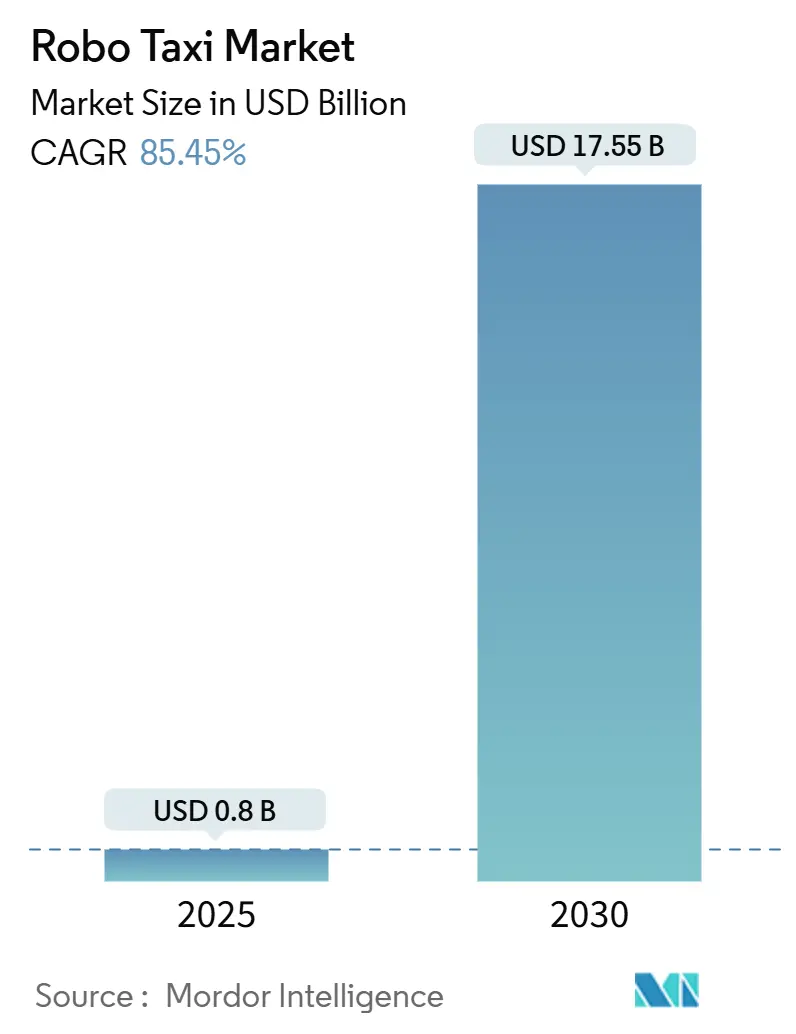
Robo Taxi Market Analysis by Mordor Intelligence
The Robo Taxi Market size is estimated at USD 0.8 billion in 2025, and is expected to reach USD 17.55 billion by 2030, at a CAGR of 85.45% during the forecast period (2025-2030). Capital inflows from strategic and financial investors continue to reset competitive dynamics, while rapid hardware deflation—most visibly in LiDAR and high-performance compute—erases a chief economic barrier. Clearer regulatory frameworks, such as Dubai’s dedicated autonomous-vehicle law and Germany’s KIRA project, convert pilot schemes into scalable commercial operations.
Key Report Takeaways
- By level of autonomy, Level 4 systems held 61.73% of the Robo taxi market share in 2024; Level 5 is projected to advance at an 87.41% CAGR through 2030.
- By propulsion, battery-electric platforms accounted for 71.32% of the Robo taxi market size in 2024 and are expanding at a 79.52% CAGR to 2030.
- By vehicle type, van and shuttle formats grew fastest at a 75.23% CAGR, while car configurations captured 67.34% revenue share in 2024.
- By application, passenger mobility commanded an 81.38% share of the Robo taxi market size in 2024 and is set to accelerate at an 89.33% CAGR toward 2030.
- By business model, business-to-business contracts are soaring at an 80.14% CAGR, while direct-to-consumer services retain a 53.81% revenue share in 2024.
- By service type, rental-based free-floating services captured 54.55% of 2024 revenue and are forecast to compound at a 79.23% CAGR through 2030, making them the largest and fastest-growing format, according to Mordor Intelligence.
- By fleet ownership, OEM-owned fleets led with 52.96% revenue share in 2024, while operator-owned TNC and start-up fleets are projected to expand at a 70.89% CAGR to 2030, according to Mordor Intelligence.
- By operating environment, urban core corridors accounted for 62.45% of 2024 revenue, whereas highway and inter-city routes are poised to grow at a 71.34% CAGR through 2030, according to Mordor Intelligence.
- By geography, Asia-Pacific holds 45.13% share in 2024, whereas it also exhibits the strongest regional CAGR at 85.23% through 2030, with China’s multi-city deployments as the principal catalyst.
Global Robo Taxi Market Trends and Insights
Drivers Impact Analysis
| Driver | (~) % Impact on CAGR Forecast | Geographic Relevance | Impact Timeline |
|---|---|---|---|
| Declining AD-Sensor and Computing Costs | +18.5% | Global, with early gains in China and North America | Medium term (2-4 years) |
| Government AV Pilots and Regulatory Sandboxes | +15.2% | North America & EU, APAC core with spill-over to MEA | Short term (≤ 2 years) |
| Urban Congestion Pricing Nudging Shared Autonomy | +12.8% | Global urban centers, concentrated in Europe and Asia-Pacific | Medium term (2-4 years) |
| MaaS Platform Integration | +11.3% | Global, with early adoption in Europe and North America | Medium term (2-4 years) |
| Purpose-Built Autonomous Van for Last-Mile Logistics | +9.7% | Global, with concentration in North America and China | Long term (≥ 4 years) |
| Record Capital Inflows into Autonomous-Mobility Ventures | +8.9% | Global, concentrated in North America and China | Short term (≤ 2 years) |
| Source: Mordor Intelligence | |||
Declining AD-sensor & computing costs
Unit-price compression in LiDAR and on-board compute redefines fleet-level economics. Chinese suppliers forecast LiDAR modules below USD 1,000, against USD 75,000 less than a decade ago, while NVIDIA’s DRIVE Hyperion platform reaches automotive-grade volume production. Hardware outlay per Level 4 vehicle fell from USD 250,000 to USD 150,000 in two model cycles. As bills of material move closer to parity with traditional vehicles, payback periods fall under three years for high-utilisation fleets. This cost trajectory improves the addressable opportunity for the robo taxi market across premium and mass-market urban zones.
Government AV pilots & regulatory sandboxes
Jurisdictions now issue commercial licences rather than test permits. Germany’s KIRA fleet carries fare-paying passengers on arterial routes, France fast-tracks driverless statutes, and Dubai’s Law No. 9 of 2023 explicitly authorises paid autonomous services. Each initiative compresses deployment lead times by clarifying liability, insurance, and data logging mandates. Predictable compliance requirements unlock long-dated capital and trigger multi-city ramp-ups, thereby expanding the immediately serviceable available market for robo taxi operators.
Urban congestion pricing nudging shared autonomy
Congestion-pricing zones in London, Singapore, and Shanghai raise the marginal cost of single-occupancy trips. Once utilisation exceeds 60%, shared autonomous fleets offer per-mile costs up to 40% lower than conventional ride-hailing. The interplay of pricing pressure, limited parking, and urban emissions caps steers demand toward pooled rides. The robot taxi market, therefore, benefits directly from municipal sustainability agendas.
MaaS platform integration unlocking fleet utilisation.
Ride-hailing platforms supply instant demand aggregation. Uber interfaces with Waymo, Pony.ai, and WeRide, while Lyft aligns with Mobileye and May Mobility. These integrations reduce customer-acquisition costs, allow a single login for human- and computer-driven rides, and lift load factors through dynamic dispatch. The model converts idle hours into revenue for fleet owners, accelerating time to positive cash flow and magnifying network effects inside the Robo taxi market.
Restraints Impact Analysis
| Restraint | (~) % Impact on CAGR Forecast | Geographic Relevance | Impact Timeline |
|---|---|---|---|
| High Upfront CAPEX and Uncertain Pay-Back | -19.2% | Global, particularly pronounced in emerging markets | Long term (≥ 4 years) |
| Persistent Public-Trust and Safety-Perception Gap | -14.7% | Global, particularly pronounced in North America and Europe | Long term (≥ 4 years) |
| Patchy Global Liability and Safety Certification Regimes | -12.8% | Global, with fragmentation across jurisdictions | Medium term (2-4 years) |
| V2X Cyber-Security Vulnerabilities | -8.3% | Global, with heightened concerns in developed markets | Medium term (2-4 years) |
| Source: Mordor Intelligence | |||
Persistent public-trust & safety-perception gap
J.D. Power’s confidence index scores just 39/100 for fully automated vehicles despite Waymo recording 90% fewer insurance claims than human drivers. Consumers in the United States and Germany cite uncertainty over software reliability and liability coverage, with 71% rejecting per-ride insurance premiums.[1]“2024 Mobility Confidence Index,” J.D. Power, jdpower.com Regional asymmetry also appears: surveys in Shanghai show higher early-adopter intent, suggesting uptake will not be uniform. Closing this gap calls for transparent incident reporting, incremental rollouts, and visible safety disclaimers, all stretching marketing budgets and deployment timelines for the robo taxi market.
V2X cybersecurity vulnerabilities
Vehicle-to-everything links are essential for high-density orchestration yet expose autonomous fleets to spoofing and denial-of-service attacks. Operators must layer encryption, hardware-rooted identity, and continuous over-the-air patching, raising non-recurring engineering costs. The absence of globally harmonised standards forces multi-vendor fleets to maintain redundant protocols, limiting economies of scale. A high-profile breach could stall approvals across multiple jurisdictions, ceasing near-term penetration until defence-in-depth frameworks mature.
Segment Analysis
By Level of Autonomy: Market migrates toward unrestricted operation
Level 4 vehicles produced the bulk of paid rides in 2024, holding 61.73% of the Robo taxi market share. They run inside geofenced metropolitan zones where high-definition maps and remote assistance offset residual edge cases. The segment grows steadily yet cedes relative weight as Level 5 prototypes prove reliability in unstructured environments. At an 87.41% CAGR, Level 5 lifts the long-run ceiling of the Robo taxi industry. Over the forecast horizon, early adopters transition fleets incrementally, often operating Level 4 and Level 5 vehicles side-by-side to amortise sunk investments while preparing for driver-out operations in all weather and terrain.
Operator economics evolve in parallel. Level 5 hardware currently carries a 15% cost premium over Level 4 equivalents, yet eliminating tele-operations and remote supervisors offsets that delta once daily utilisation exceeds eight hours. Waymo’s latest design-to-cost cycle already narrows the premium, signalling an inflection at which Level 5 becomes the default procurement choice for fleet expansions.
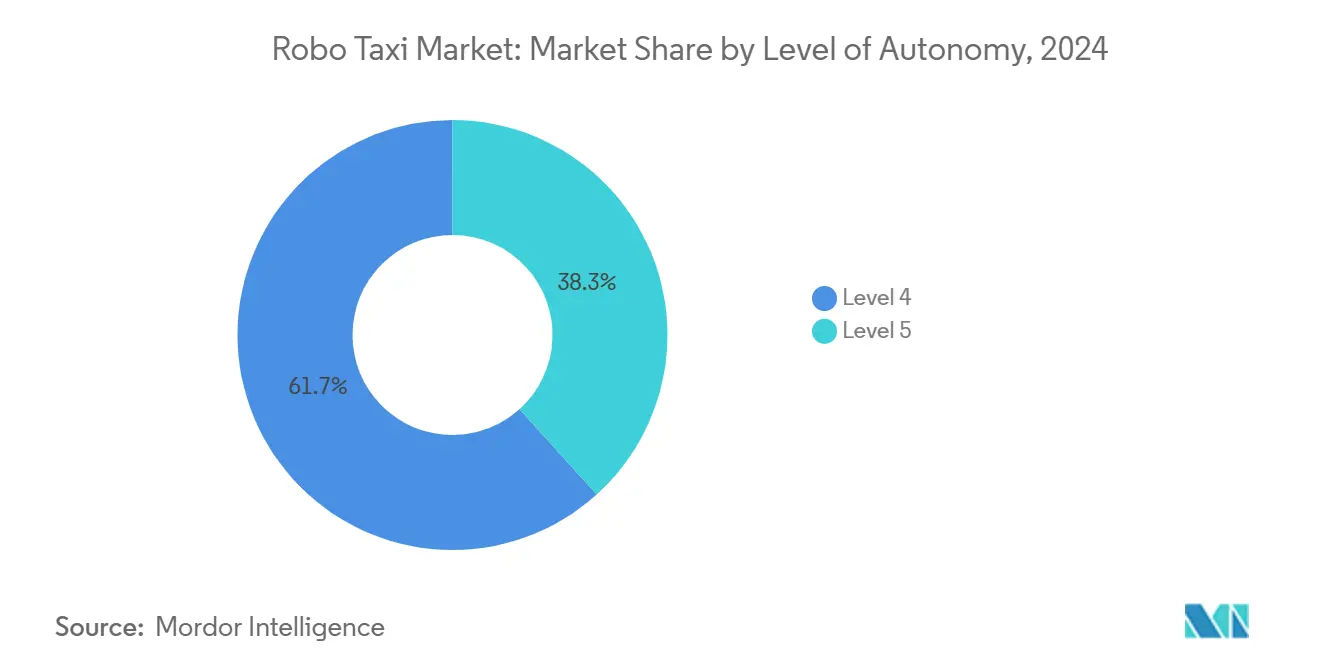
By Propulsion: Electric platforms cement cost leadership
Battery-electric drivetrains held a 71.32% market share in 2024 and exhibit a 79.52% CAGR. Electric powertrains harmonise with autonomous-vehicle duty cycles: regenerative braking, low service intervals, and central depot charging align with high-mileage, round-the-clock operations. The Robo taxi market, therefore, favours electric fleets when evaluating total cost of ownership against internal combustion or hybrid alternatives. Inductive charging pads at curbside stands in Phoenix and Wuhan further truncate dwell time, helping fleets maintain ride availability targets above 90%.
Fuel-cell and hybrid alternatives retain relevance in long-range or temperature-extreme routes where battery performance degrades. However, new chemistries such as lithium-iron-phosphate reduce cost per kilowatt-hour by 30% relative to nickel cobalt manganese packs, extending electric competitiveness into regional shuttles. Automakers dedicate separate battery lines for autonomous-mobility clients, lowering variance and frontline downtime.
By Vehicle Type: Vans and shuttles unlock new demand pools
Car-based designs captured 67.34% of 2024 revenue due to legacy ride-hailing user expectations. Yet van and shuttle formats compound fastest at a 75.23% CAGR as operators pivot to multi-passenger or cargo-dense missions. Purpose-built shapes gain regulatory favour because their reduced front crumple zones free interior volume without compromising passive safety when no human driver is on board.
Product-development feedback loops tighten as digital twins simulate millions of kilometres before hardware freeze. Design for manufacturability disciplines drive part-count reductions near 18%, lowering bill-of-materials risk for low-volume skews. Consequently, the Robo taxi market moves from retrofit approaches, where sensor pods protrude from traditional sedans, to integrated exteriors that conceal perception arrays.
By Application: Passenger mobility remains the anchor revenue stream
Passenger services held an 81.38% share in 2024 and widened at an 89.33% CAGR. Legacy ride-hailing habits, smartphone-based booking, and urban congestion charges converge to lift adoption. The Robo taxi market size derived from passenger fares is projected to compound in double digits as average fare-box revenue per mile declines and elasticity draws incremental riders. Goods and parcel movements, with 18.62% share, nevertheless sprint at 81.32% CAGR, supported by e-commerce surges beyond 20 parcels per capita per week in Tier-1 Chinese cities.
Synchronised fleets that toggle between people and parcels during slack periods raise utilisation, trimming payback cycles. Regulatory carve-outs for late-night goods-only windows, such as those piloted in Los Angeles freight corridors, create off-peak revenue that smooths daily demand curves. As urban fulfilment sites move closer to consumers, sub-20-minute delivery promises generate premium-rate trips, diversifying operator cash flows.
By Service Type: Free-floating rental gains traction
Free-floating rental commanded a 54.55% share in 2024 and accelerates at 79.23% CAGR, outpacing hub-based models that require passengers to start or end at defined locations. App-based access lowers transaction friction and mimics existing ride-hail experiences, giving free-floating fleets a behavioural advantage.
Operators calibrate geo-fencing algorithms to manage vehicle density and avoid supply imbalances. Over time, predictive repositioning cuts empty-car kilometres by 25%, lifting net revenue margin. For hub-centric operations, predictable depot economics continue to appeal in airport runs and fixed corporate campus loops, sustaining a healthy niche even as consumer preference skews toward spontaneity.
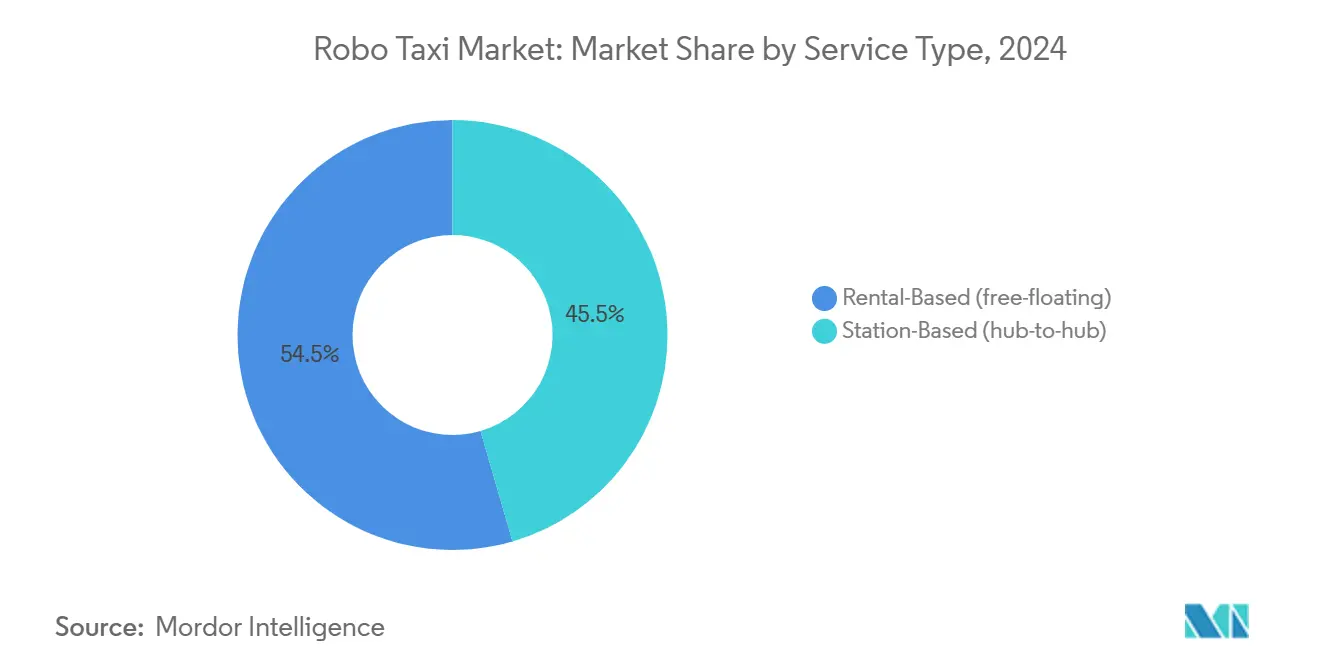
By Business Model: Corporate contracts de-risk early expansion
The business-to-business segment records the quickest trajectory at 80.14% CAGR, even though direct-to-consumer offerings still hold 53.81% revenue share. Logistics firms hedge driver shortages and rising wages by signing multi-year service-level agreements with autonomous-mobility providers.
Corporate shuttle deals in Silicon Valley and Shenzhen guarantee baseline utilisation, enabling operators to amortise hardware quicker and build safety track records critical for subsequent consumer marketing. Bundled maintenance and telematics analytics further embed robo taxi operators in client workflows, raising switching costs and stabilising revenue streams.
By Fleet Ownership: Specialised operators enter the spotlight
Original-equipment manufacturers controlled 52.96% of 2024 fleets, reflecting early vertical-integration experiments. Yet specialised operator ownership outpaces all at 70.89% CAGR as asset-light platform companies concentrate on software, rider experience, and demand generation.
Financiers structure vehicle-as-a-service leases, shifting capital intensity off operator balance sheets. This model accelerates fleet renewals every three to four years, thus keeping perception hardware current without burdensome retrofit programmes. Public-agency ownership rises as municipalities embed autonomous shuttles into transit networks, aligning with climate targets and social-equity mandates.
By Operating Environment: Highways become the next frontier
Urban cores contributed 62.45% revenue in 2024, yet highway and inter-city trips compound at 71.34% CAGR. Long-distance corridors reveal fewer pedestrian interactions, allowing higher average speeds and truncated perception compute loads. This translates into extended battery range and lower per-mile energy cost.
State transport departments in Texas and Guangdong allocate dedicated autonomous lanes that sidestep mixed traffic, simplifying certification. Sub-urban and campus environments maintain mid-70% growth rates as gated-road layouts and low-speed limits provide favourable proving grounds before city-centre introductions.
Geography Analysis
Asia-Pacific anchors global upside, with a 45.13% share in 2024. China already licenses robotaxis in 16 cities, and policy goals envision 1,000 fully driverless vehicles in Wuhan by 2028. Government procurement incentives, free-trade-zone test beds, and 5G coverage create a virtuous infrastructure loop. As a result, the Robo taxi market in Asia-Pacific is compounding at an 85.23% CAGR. Multinational fleets leverage this regulatory tailwind to prototype features such as multilingual voice UX and integrated in-vehicle payments, which then migrate to export markets.
North America remains the operational benchmark owing to Waymo’s 200,000 weekly rides across Phoenix, San Francisco, and Los Angeles. State-level autonomy statutes differ, but 27 states and Washington D.C. already authorise Level 4 or Level 5 rides, yielding the continent’s most diverse route portfolios. In North America as capital inflows continue—Waymo alone secured USD 5.6 billion in 2024 funding rounds. Tesla prepares an Austin pilot to stress-test driverless rides on mixed-speed arterials, signaling that competitive intensity remains robust despite Cruise’s recent retrenchment.
Europe is propelled by Germany’s KIRA project and France’s nationwide driverless roadmap. Dense medieval street grids and GDPR compliance obligations add operational complexity, yet cities such as Hamburg, Paris, and Barcelona pursue zero-emission corridors that explicitly accommodate autonomous shuttles. Strategic alliances like Wayve–Uber in London integrate British AI stacks with ride-hailing volume, providing a template for continent-wide scaling once harmonised EU regulation takes effect.[2]“Autonomous Mobility Partnerships Fact Sheet 2025,” Uber Technologies, uber.com
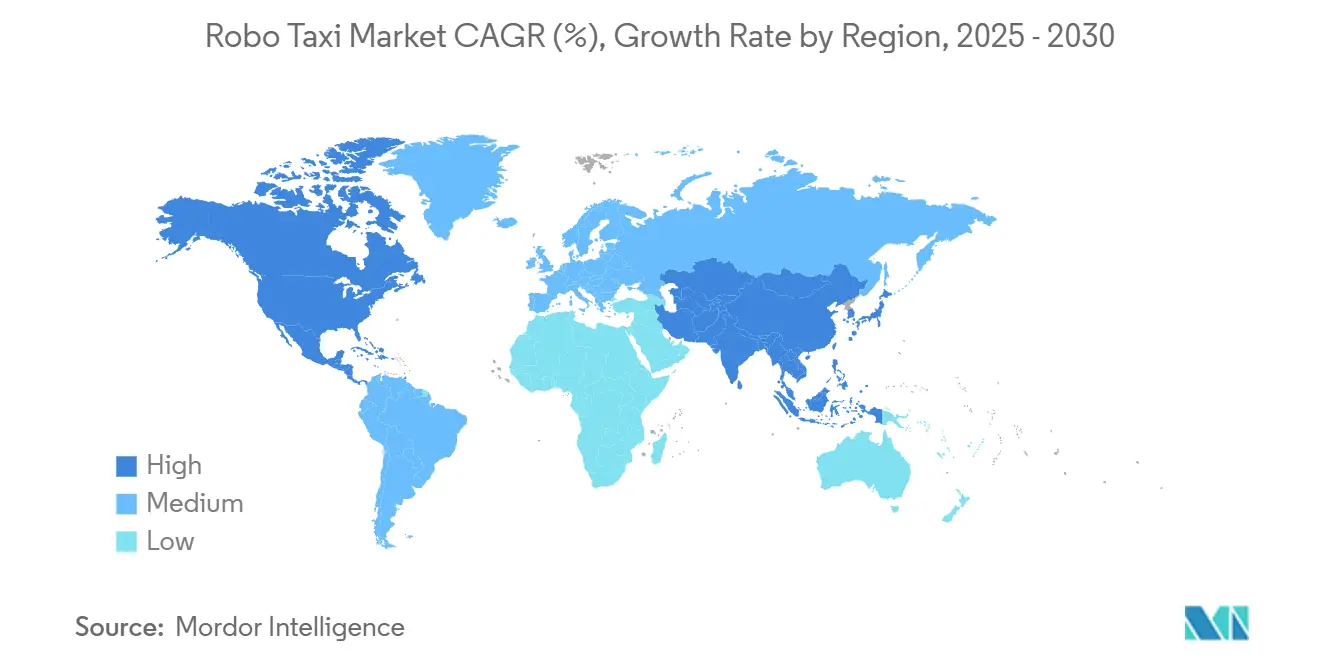
Competitive Landscape
The robo taxi market coalesces around a handful of capital-rich leaders. Waymo tops paid-ride metrics, backed by USD 11.1 billion cumulative funding and a pipeline factory partnership with Magna that secures chassis supply at scale. Chinese peers Baidu, Pony.ai, and WeRide translate domestic cost efficiencies into overseas expansion; Baidu’s Apollo Go logged more than 1.4 million rides in Q1 2025 and will place 100 vehicles in Dubai before year-end. NVIDIA’s DRIVE Hyperion platform compresses development cycles for smaller entrants, enabling them to license validated reference hardware rather than design from scratch.[3]“NVIDIA DRIVE Hyperion Platform Achieves Critical Automotive Safety and Cybersecurity Milestones for AV Development,” NVIDIA, nvidia.com
Industry structure, however, is not static. Platform aggregators like Uber and Lyft lower distribution barriers for emerging technology suppliers, broadening geographic coverage without duplicative customer-acquisition spend. Regional champions in the Middle East, Southeast Asia, and South America carve niches through knowledge of local regulation and ride-hail ecosystem quirks.
Traditional automakers reassess capital allocation after Cruise’s pause; some pivot to supplying purpose-built chassis while ceding software to specialist stacks. Strategic moves highlight a shift from pure autonomy milestones to sustained unit-economics performance, making cost per mile and ride-completion ratio the principal metrics that decide market leadership.
Robo Taxi Industry Leaders
-
Waymo LLC
-
GM Cruise LLC
-
Baidu Apollo
-
AutoX Inc.
-
Pony.ai
- *Disclaimer: Major Players sorted in no particular order
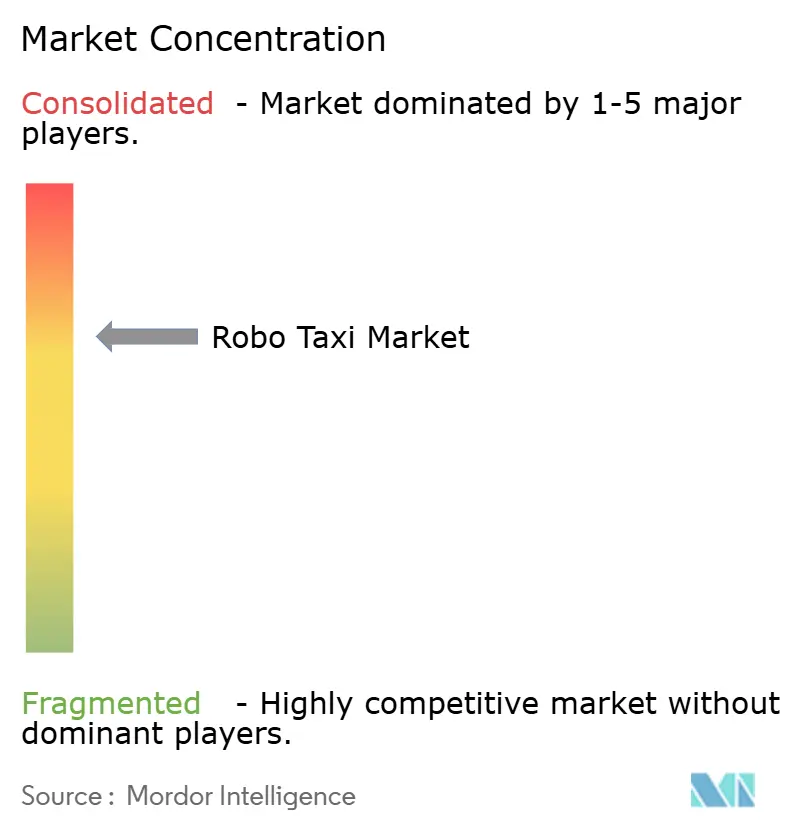
Recent Industry Developments
- June 2025: Pony AI Inc. agreed with Shenzhen Xihu Corporation Limited to deploy more than 1,000 Gen 7 robotaxis in Shenzhen, the largest single-city commitment in China.
- June 2025: Wayve and Uber began Level 4 trials in London, the first large-scale autonomous pilot in the UK capital.
- May 2025: WeRide secured a USD 100 million equity injection from Uber to expand services into 15 additional cities and lift fleet count to over 1,200 units.
- May 2025: Waymo and Magna announced an Arizona factory dedicated to robo taxi production, reducing reliance on third-party vehicle suppliers.
Research Methodology Framework and Report Scope
Market Definitions and Key Coverage
Our study defines the robo-taxi market as revenue generated by fully autonomous (SAE Level 4 or 5) passenger cars and van-shuttles that provide on-demand rides on public roads without a human safety driver.
Scope exclusion: low-speed sidewalk robots, sub-25 km/h campus shuttles, and privately owned self-driving cars are outside the count.
Segmentation Overview
- By Level of Autonomy
- Level 4
- Level 5
- By Propulsion
- Battery-Electric Vehicles
- Hybrid-Electric Vehicles
- Fuel-Cell Electric Vehicles
- By Vehicle Type
- Car
- Van / Shuttle
- By Application
- Passenger Transportation
- Goods / Parcel Transportation
- By Service Type
- Rental-Based (free-floating)
- Station-Based (hub-to-hub)
- By Business Model
- B2C (direct to riders)
- B2B (corporate / logistics contracts)
- Public-Transit Integration
- By Fleet Ownership
- OEM-Owned
- Operator-Owned (TNCs & start-ups)
- Public-Agency-Owned
- By Operating Environment
- Urban Core
- Sub-Urban / Campus
- Highway / Inter-city
- Mixed-Use Zones
- By Geography
- North America
- United States
- Canada
- Rest of North America
- South America
- Brazil
- Argentina
- Rest of South America
- Europe
- Germany
- United Kingdom
- France
- Italy
- Spain
- Russia
- Rest of Europe
- Asia-Pacific
- China
- Japan
- India
- South Korea
- Rest of Asia-Pacific
- Middle East and Africa
- Turkey
- Saudi Arabia
- United Arab Emirates
- South Africa
- Nigeria
- Rest of Middle East and Africa
- North America
Detailed Research Methodology and Data Validation
Primary Research
Interviews with autonomous-vehicle engineers, fleet managers, municipal regulators, and mobility insurers across North America, Europe, and Asia tested secondary assumptions, closed cost gaps, and refined adoption curves. Short online surveys supported regions where interviews were fewer.
Desk Research
We, the Mordor team, mapped ride-hailing demand and fleet potential through open datasets such as International Transport Forum trip statistics, US Bureau of Transportation Statistics ride-share panels, Eurostat urban mobility surveys, Chinese MIIT electric-taxi logs, and UN-Habitat city density files. Company filings inside D&B Hoovers, news flows on Dow Jones Factiva, patent sets within Questel, plus releases from NHTSA and UNECE clarified sensor prices, regulatory timing, and fleet launch milestones. Trade journals and association papers flagged fresh deployments. The list is illustrative; many additional sources informed validation.
Market-Sizing & Forecasting
We first estimate total ride-hailing kilometers by city cluster (top-down). Then, we apply penetration curves for Level 4/5 services. Selective bottom-up fleet roll-ups and sampled fare × kilometer checks validate totals. Key inputs include approval cadence, battery $/kWh, LiDAR unit cost, urban density, and fleet utilization hours. A multivariate regression, tempered with exponential smoothing for near-term shocks, projects these variables through 2030.
Data Validation & Update Cycle
Outputs pass dual-analyst reviews and variance scans against autonomous miles driven, LiDAR shipments, and venture funding totals. Reports refresh annually, with interim updates triggered by material events, so clients always receive the latest view.
Why Mordor's Robo Taxi Market Baseline Earns Unmatched Trust
Published estimates often diverge because firms mix personal AV sales, assume instant global rollouts, or apply flat fares that ignore idle time.
Our study sticks to Level 4/5 fleets, models city readiness one by one, and reports in constant 2025 dollars, which steadies currency swings.
Benchmark comparison
| Market Size | Anonymized source | Primary gap driver |
|---|---|---|
| USD 0.8 B (2025) | Mordor Intelligence | - |
| USD 4.43 B (2025) | Global Consultancy A | Counts personal AV sales and wider MaaS revenue |
| USD 2.00 B (2025) | Trade Journal B | Assumes rapid cross-border rollout, ignores idle time |
| USD 1.95 B (2024) | Industry Research C | Uses earlier base year and single global fare |
For example, one global consultancy values the 2025 market at USD 4.43 billion, while a trade journal article places it near USD 2 billion, and an industry research note sets 2024 at USD 1.95 billion.
These contrasts show how Mordor's disciplined variable selection and frequent refresh deliver a balanced, transparent baseline that decision-makers can readily trace and repeat.
Key Questions Answered in the Report
What is the current size of the robo taxi market?
The market generated USD 0.8 billion in 2025 and is forecast to reach USD 17.55 billion by 2030, reflecting an 85.45% CAGR.
Which region will see the fastest growth?
Asia-Pacific leads with an 85.23% CAGR through 2030, led by aggressive Chinese deployments and supportive regulation.
How dominant are battery-electric robo-taxis?
Battery-electric vehicles captured 71.32% of 2024 revenue and are advancing at a 79.52% CAGR, making them the preferred propulsion system.
What restrains market adoption the most?
Persistent public-trust concerns reduce projected CAGR by 14.7% despite strong safety records, requiring extensive outreach and transparent reporting.
Which business model is scaling quickest?
Business-to-business contracts grow at 80.14% CAGR as logistics and corporate shuttle clients lock in long-term service agreements that stabilise fleet utilisation.
How are governments influencing deployment?
Dedicated laws and pilot schemes, such as Dubai’s Law No. 9 of 2023 and Germany’s KIRA project, provide legal clarity that accelerates commercial roll-outs while reducing investment risk.
Page last updated on:



